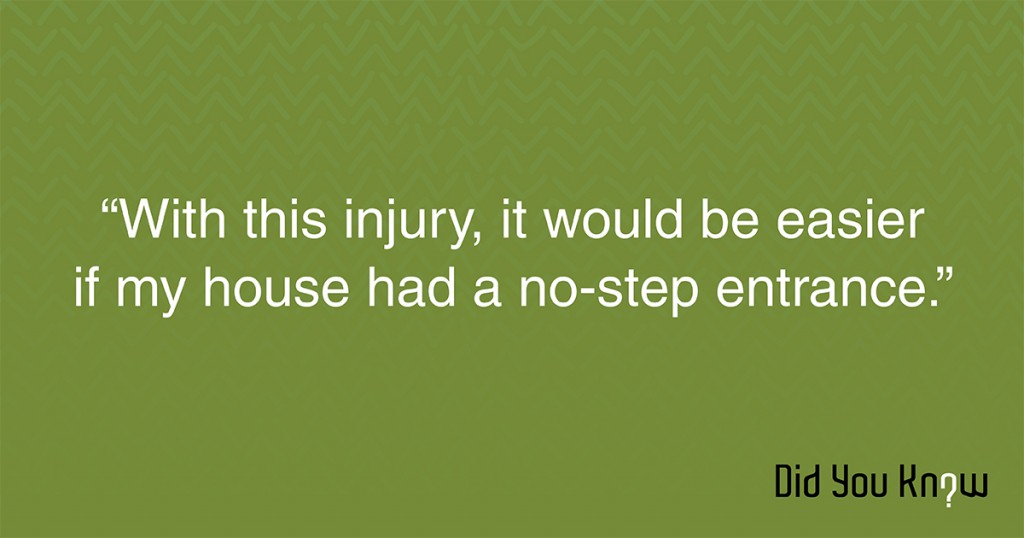- A
- A
- A

Did you know that houses with steps at all entrances, narrow doorways, long and narrow hallways, and no bathroom on the main floor are barriers for many people? These building barriers cause difficulty for nondisabled people to accommodate friends and relatives, who need basic accessibility, visiting their homes. These barriers can also make it difficult for older adults to remain in their homes over time and also come with risks of injuries to both homeowners and visitors.
Did you know that to address this issue, housing accessibility advocates created a concept known as “visitability?” Visitability is a design method that incorporates simple basic accessibility features as a normal construction process into newly built single-family housing. The three main visitability features are a no-step entrance, doorways with thirty-two inches of clear passage space, and a half or full bathroom on the main floor. These features can be easily assimilated inexpensively into the design and construction of new homes.
Did you know that current homeowners can make these modifications to their existing homes to provide access to visitors and to also target their future plans of staying in homes longer? You can research and seek consultation with Certified Aging-in-Place Specialists to explore options for modifying your home to be visitable. Homeowners can use family resources or publicly financed home modification programs for renovations to remove barriers from existing homes.
Did you know that many people age 55 and older who live at home want to age in place? “Aging in place” allows older adults to live independently in their current residence or community for as long as possible, including being provided with long-term care services and supports in the home. AARP’s survey shows that a “majority of older adults want to remain in their homes and communities as they age.” The ability to age in place is decided by the design and accessibility of the home and features of the community, such as availability of nearby shops and transportation options.
Did you know that aging in place delays or completely avoids a move to an assisted living facility or an institutional setting? Independent living with aging in place improves health, life fulfillment, and self-esteem. Aging in place is also less expensive in the long run. For information about the costs of long-term care in various situations, see Genworth’s report.

Did you know that no-step entrances, wider hallways, and larger doorways provide benefits to a wide range of needs for homeowners and visitors? For example, visitability perks could apply to homeowners or relatives using adaptive equipment due to temporary disabilities, parents pushing baby strollers, or safe delivery of furniture and large packages into the home. Also, emergency personnel, such as firefighters and emergency medical technicians, could enter and exit homes with ease while helping crisis victims.
Did you know that promoting access in your home also promotes inclusivity for people with disabilities in the community? People with mobility disabilities are included in society with visitability accessible features in homes. For example, if a boss has a holiday party at their house, a wheelchair user could go to socialize with their peers.
For instance, you are throwing a Super Bowl bash or a holiday dinner party and inviting all your friends or coworkers to your house. One of your friends/coworkers in a wheelchair is forced to decline your invitation because they know your home is not accessible or visitable. Thus, resulting in the individual being left out of your party and feeling unwelcome in the community.
Not only do the visitability modifications welcome people with disabilities, your out-of-town guests or visiting older adults will also be welcomed, especially if hotels are fully booked in your area.
A visitable home allows you to invite anyone into your home and make everyone feel welcome.

Did you know that “universal accessibility” is a new addition to the Leadership in Energy and Environmental Design (LEED) Green Building Rating System? This means that while LEED is a national accepted green program certifying high-performance green buildings, there is a new LEED-Neighborhood Development, LEED-ND, certification program that is a standard for neighborhood design and includes a credit for “universal accessibility!” For details about the credit for LEED-ND- look to U.S. Green Building Council’s website. For more information about LEED-ND initiative, check out A Citizen’s Guide to LEED for Neighborhood Development: How to Tell if Development is Smart and Green.
Did you know that there are some visitability bylaws and ordinances in the works in some cities and states? Some states have legal restrictions regarding local visitability ordinances. Some local legislations are restricted from exceeding the requirements of the State Building Construction Code, so some cities in those states adopted voluntary and incentive-based programs to promote visitability. Check with your state and city to find out about local incentive programs!
There are some ways you can get involved to help your community adapt to the visitability movement. Check out the resources offered by Grantmakers in Aging’s Community AGEnda Initiative. If you want to get involved to propose visitability as a town by-law or city ordinance, you can use Massachusetts Municipal Lawyers Association’s guidance.
The more you know about the visitability, the better idea you will have of considering adding three basic accessible features to your current or new home. While universal accessible features in the home provide easy access for people with mobility disabilities, these designs are also friendly for families with small children, visiting seniors, and aging in place. Homes that are built or modified for the visitability movement make the community inclusive and also come with accessible, all-around benefits to your visiting friends, relatives, and yourself.
Tips:
When you are considering making your home accessible, check out the tips below to give you a better idea of how you can incorporate these features into your floorplan.
- Key Features:
- Ramp/no-step into house/condo
- First floor bathroom with basic maneuvering space
- Interior doorways to be a minimum of 32 inches wide
- These are the three important basic architectural conditions to make a home visitable.
- Optional Features:
- Front door entrance to be a minimum of 36 inches wide
- Reinforced bathroom walls to support grab bars
- Levered door handles, single-lever kitchen and bathroom faucets
- Raised electrical outlets to 18 inches from the floor
- Lowered climate control and light switches
Resources: